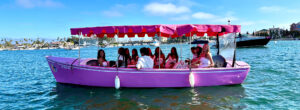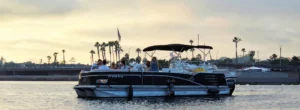Introduction
Renting a boat offers the perfect opportunity to explore the open water, relax, and create unforgettable memories. However, safety should be the top priority before setting off on any boating adventure. A few careful preparations can make a significant difference in ensuring a smooth and enjoyable trip. This safety checklist covers everything you need to review and confirm before embarking on a boat rental, from understanding the vessel to preparing for emergencies.
Following a safety checklist helps ensure that you’re well-prepared for any potential challenges and can enjoy your day on the water worry-free. With the right preparations, you can focus on what matters most: enjoying the journey and staying safe.
Understanding the Vessel and Its Equipment
Before setting sail, it’s essential to familiarize yourself with the vessel. Each boat may have unique controls, safety features, and layouts. Take time to go through the boat’s operation manual if provided, or ask the rental staff for an overview. Make sure you know how to operate key features, such as the engine, throttle, anchor, and bilge pump, which helps remove any accumulated water.
Check if the boat has functional navigation lights, especially if you plan to be out during dawn, dusk, or night. Ensure you know where all essential equipment is stored, such as the fire extinguisher, first-aid kit, and signaling devices. Knowing the layout and features of your rental boat makes the trip more comfortable and safe.
If you’re unfamiliar with the boat type, ask for a quick demonstration from the rental provider. Having a strong understanding of the vessel will give you confidence and improve your overall safety on the water.
Checking Weather Conditions
Weather can drastically affect boating safety, so it’s critical to check the forecast before departing. Keep an eye on weather changes, even if the forecast looks favorable. Sudden shifts in wind speed, temperature, or storm warnings can indicate that conditions are deteriorating, which may be dangerous on the water.
Reliable sources such as the National Weather Service (NWS) or mobile weather apps can provide real-time updates. Avoid boating if thunderstorms, heavy winds, or fog are expected, as these conditions can create difficult and hazardous conditions. High winds and waves, for instance, can make it challenging to control the boat and increase the risk of capsizing.
If you’re already on the water and notice weather changes, head back to shore or find a sheltered area as soon as possible. Staying aware of the weather is a proactive way to keep everyone on board safe.
Reviewing Navigation and Area Maps
Understanding the area in which you’re boating is essential for navigation and safety. Before setting out, review maps of the local waterways, especially if it’s your first time in the area. Make note of shallow spots, restricted zones, and areas with heavy boat traffic to avoid unplanned challenges.
Many boat rentals come with GPS systems or map applications, which can be valuable tools for real-time navigation. It’s wise to carry a physical map as well in case of technical difficulties. Knowing where you are and where you’re going will keep you on course and away from hazardous areas.
Plan a basic route for your trip, factoring in time for stops, sightseeing, or fishing spots. By reviewing navigation routes beforehand, you can reduce the chance of getting lost or ending up in unfamiliar waters.
Ensuring Proper Life Jacket Use
Life jackets are one of the most critical safety items on any boat, and they are legally required in many areas. Make sure there is a properly fitting life jacket for every person on board, including children. Life jackets should be U.S. Coast Guard-approved and suited for each individual’s weight and size.
Before departing, have everyone try on their life jacket to confirm a snug fit. A life jacket that’s too loose or too tight won’t offer the necessary protection in case of an emergency. Ensure everyone knows how to properly secure and use their life jacket.
It’s recommended to wear life jackets at all times, especially when the boat is in motion. Accidents can happen unexpectedly, and wearing a life jacket significantly increases your chances of staying safe on the water.
Checking Fuel and Battery Levels
Running out of fuel or experiencing battery failure on the water can turn a pleasant outing into a frustrating and potentially dangerous situation. Before setting off, check the fuel gauge and make sure you have enough for the trip and any unforeseen detours. Rental boats should be supplied with a full tank, but always double-check.
Similarly, confirm that the boat’s battery is fully charged. Many boats have dual-battery systems, so be sure that both are charged and functioning. If you’re unfamiliar with how the boat’s battery system works, ask the rental provider for a quick explanation.
Having adequate fuel and battery power is essential to prevent getting stranded on the water. Always err on the side of caution by ensuring you have more than enough for your planned outing.
Confirming Communication Devices Are Functional
Reliable communication devices are essential for safe boating, especially if you’re venturing far from shore. Check that the boat has a functioning VHF radio, which allows you to communicate with nearby vessels and emergency services. If the boat doesn’t have a radio, consider bringing a fully charged cell phone as an alternative.
Cell service can be spotty in some areas, so it’s best not to rely solely on your phone for communication. A VHF radio remains the most dependable option for staying connected on the water. Test any communication devices before you leave the dock to ensure they’re working properly.
It’s wise to have emergency contacts saved on your device or written down. Being able to call for assistance or relay your location in an emergency can make all the difference in a critical situation.
Preparing an Emergency Kit
An emergency kit is a vital component of any safe boating experience. This kit should include essentials such as a first-aid kit, waterproof flashlight, spare batteries, a whistle, and a signaling mirror. Additional items like seasickness tablets, sunscreen, and insect repellent can also come in handy during your trip.
Pack the emergency kit in a waterproof bag to keep it safe and dry. Place it somewhere accessible so you can quickly grab it if necessary. Review the contents of the emergency kit periodically to ensure everything is functional and restock any expired items.
Having a well-prepared emergency kit can provide peace of mind and ensure you’re ready for unexpected situations on the water. It’s a small step that goes a long way in enhancing safety.
Informing Someone of Your Trip Plan
Before embarking, let someone on land know about your boating plans. Share details about where you’re going, how long you expect to be out, and who is with you. This precaution can make it easier for help to reach you if something goes wrong.
Provide a general outline of your route, estimated return time, and any contact numbers in case of emergency. Some boaters choose to leave this information with the rental company as well. In the event of unforeseen delays, someone on land will know when and where to start looking if you don’t return on time.
This step, often called a float plan, is particularly important if you’re heading out to less-traveled areas or planning a longer trip. Informing others of your trip can provide an additional safety net in case of emergency.
Conclusion
Preparing for a boat rental involves more than just gathering supplies and finding the right crew—it requires a focus on safety. By following this safety checklist, you can ensure that you’re well-prepared for any challenges that might arise on the water. From understanding the vessel to checking fuel and communication devices, each step plays a role in creating a safe and enjoyable boating experience.
With the right preparations, you’ll be ready to relax and fully enjoy the time on the water. Keep these safety tips in mind, and you’ll be set for a worry-free day of adventure. So gear up, stay safe, and make the most of your boating journey!
Excited for an adventure with us or have a question? Call us at: (949) 675-8433 Book Your Ride with us: Click here to Book


